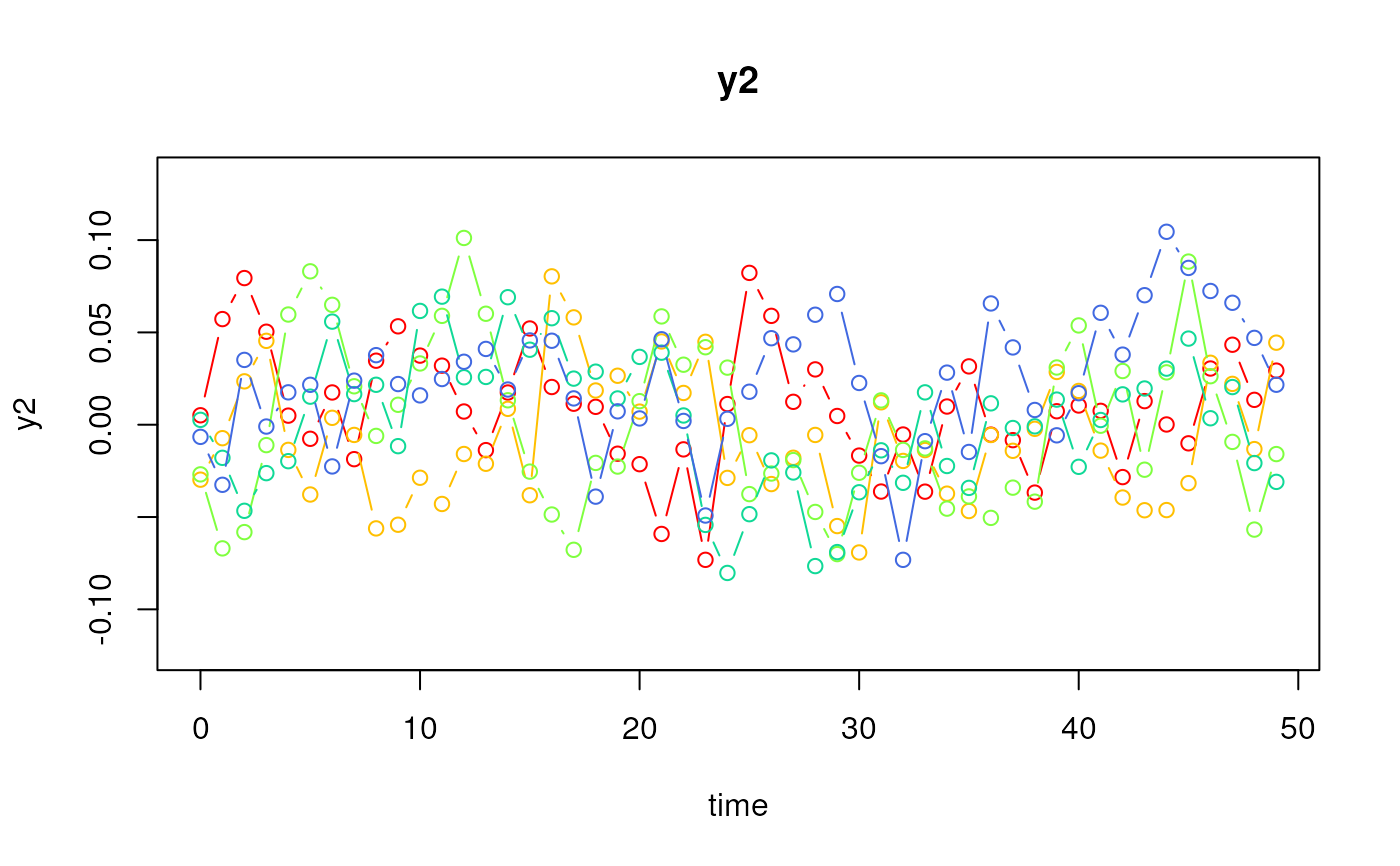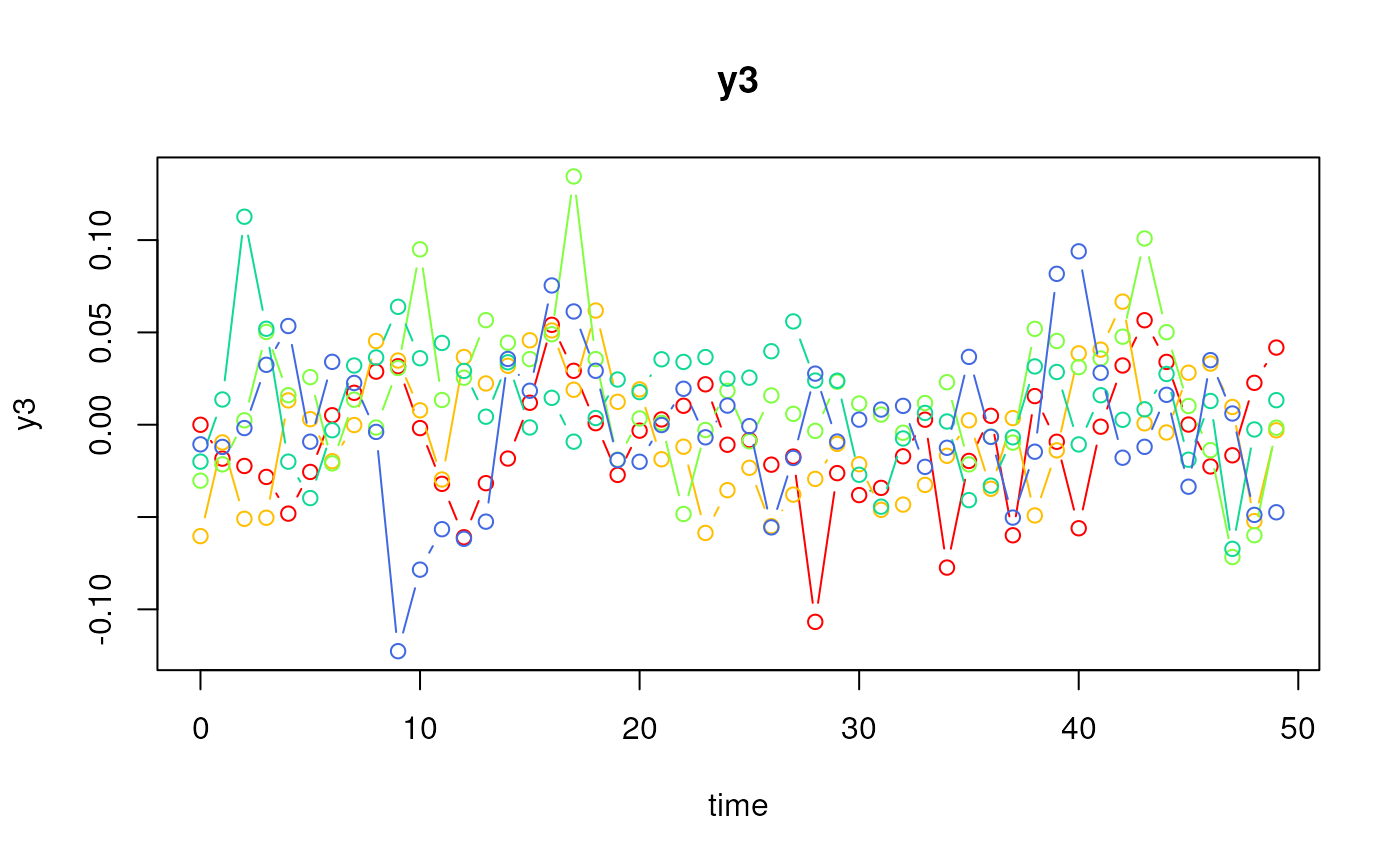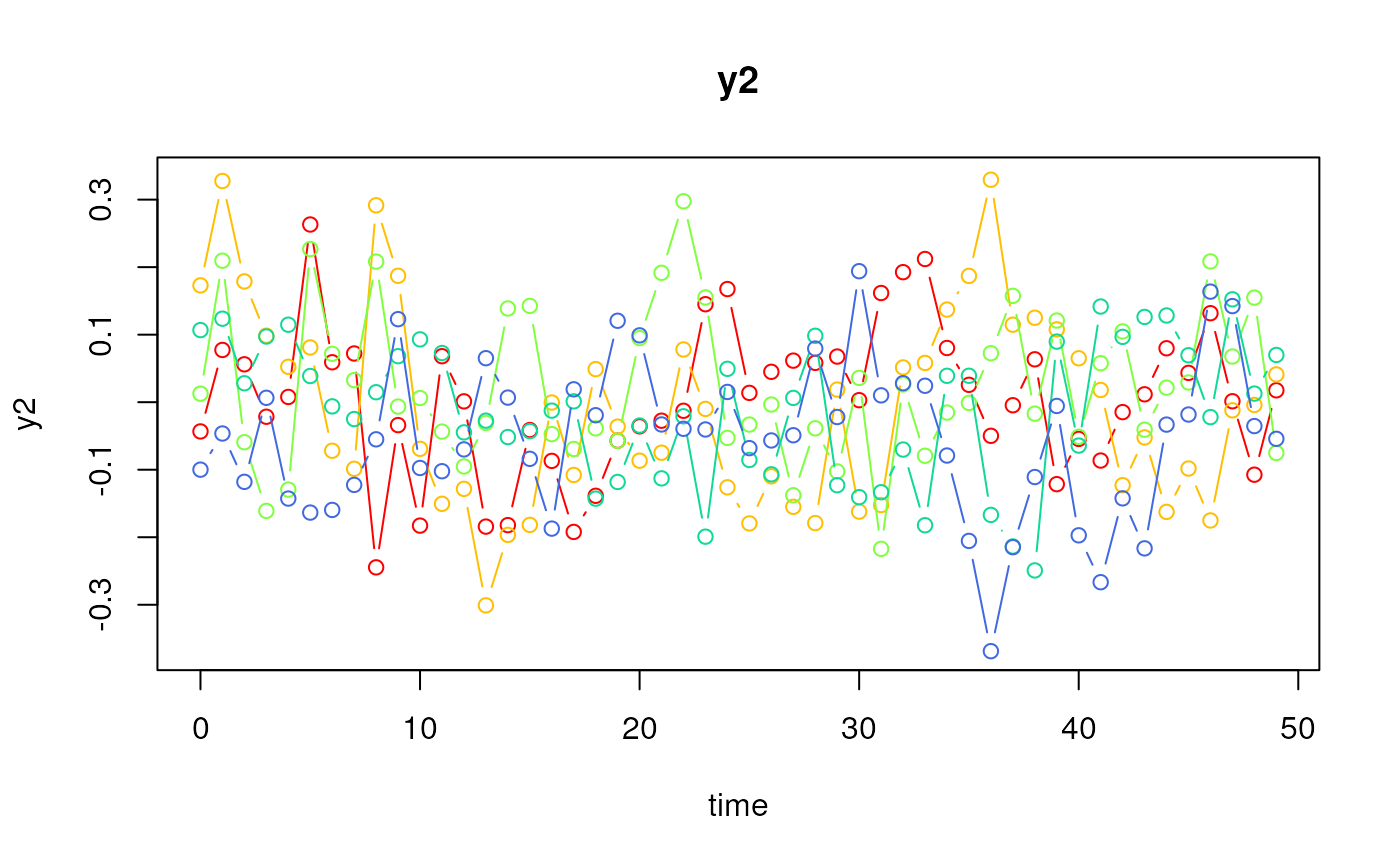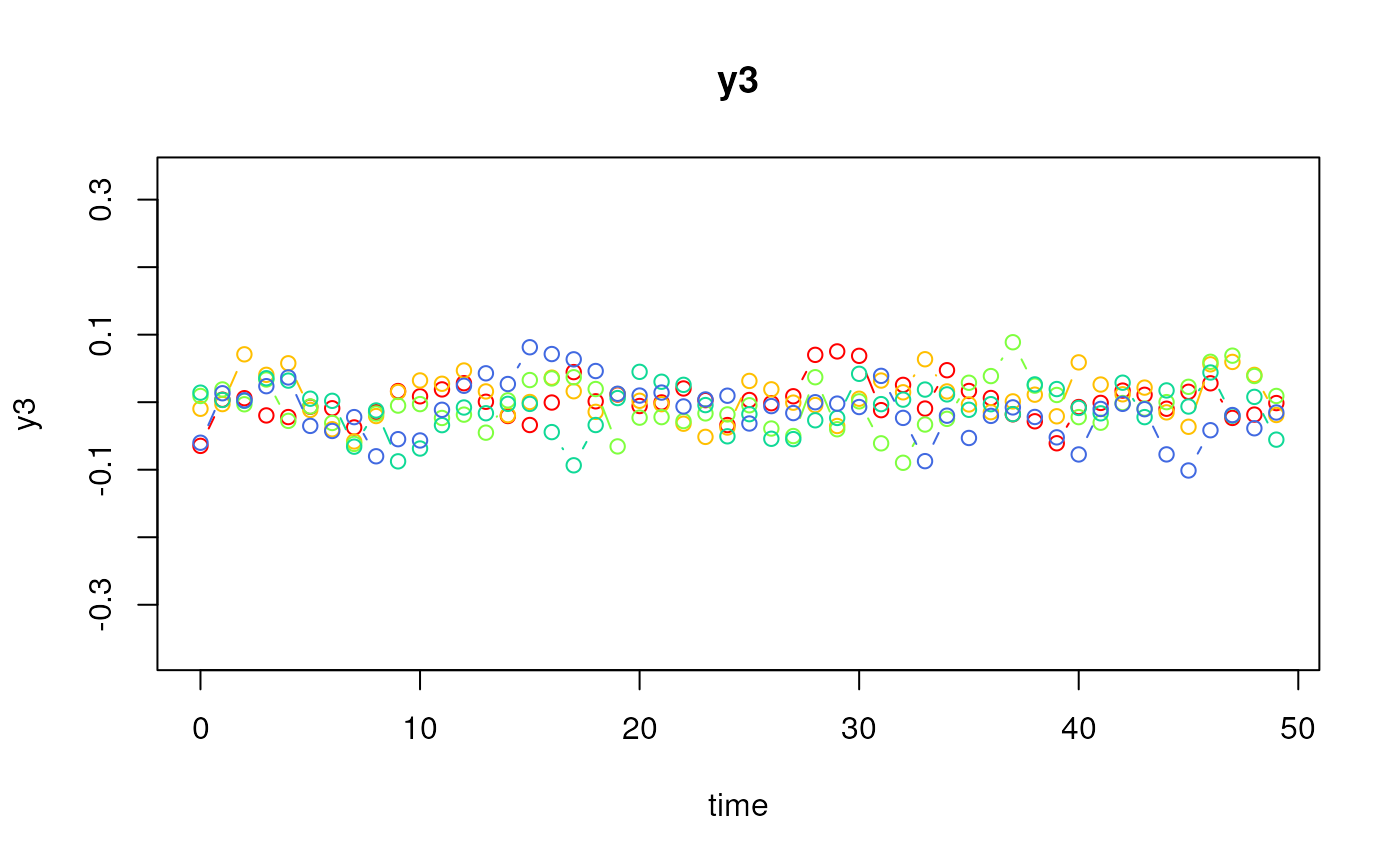Simulate Data from the Vector Autoregressive Model (Fixed Parameters)
Source:R/simStateSpace-sim-ssm-var-fixed.R
SimSSMVARFixed.RdThis function simulates data from the vector autoregressive model using a state space model parameterization. It assumes that the parameters remain constant across individuals and over time.
Usage
SimSSMVARFixed(
n,
time,
mu0,
sigma0_l,
alpha,
beta,
psi_l,
type = 0,
x = NULL,
gamma = NULL
)Arguments
- n
Positive integer. Number of individuals.
- time
Positive integer. Number of time points.
- mu0
Numeric vector. Mean of initial latent variable values (\(\boldsymbol{\mu}_{\boldsymbol{\eta} \mid 0}\)).
- sigma0_l
Numeric matrix. Cholesky factorization (
t(chol(sigma0))) of the covariance matrix of initial latent variable values (\(\boldsymbol{\Sigma}_{\boldsymbol{\eta} \mid 0}\)).- alpha
Numeric vector. Vector of constant values for the dynamic model (\(\boldsymbol{\alpha}\)).
- beta
Numeric matrix. Transition matrix relating the values of the latent variables at the previous to the current time point (\(\boldsymbol{\beta}\)).
- psi_l
Numeric matrix. Cholesky factorization (
t(chol(psi))) of the covariance matrix of the process noise (\(\boldsymbol{\Psi}\)).- type
Integer. State space model type. See Details for more information.
- x
List. Each element of the list is a matrix of covariates for each individual
iinn. The number of columns in each matrix should be equal totime.- gamma
Numeric matrix. Matrix linking the covariates to the latent variables at current time point (\(\boldsymbol{\Gamma}\)).
Value
Returns an object of class simstatespace
which is a list with the following elements:
call: Function call.args: Function arguments.data: Generated data which is a list of lengthn. Each element ofdatais a list with the following elements:id: A vector of ID numbers with lengthl, wherelis the value of the function argumenttime.time: A vector time points of lengthl.y: Albykmatrix of values for the manifest variables.eta: Albypmatrix of values for the latent variables.x: Albyjmatrix of values for the covariates (when covariates are included).
fun: Function used.
Details
Type 0
The measurement model is given by $$ \mathbf{y}_{i, t} = \boldsymbol{\eta}_{i, t} $$ where \(\mathbf{y}_{i, t}\) represents a vector of observed variables and \(\boldsymbol{\eta}_{i, t}\) a vector of latent variables for individual \(i\) and time \(t\). Since the observed and latent variables are equal, we only generate data from the dynamic structure.
The dynamic structure is given by $$ \boldsymbol{\eta}_{i, t} = \boldsymbol{\alpha} + \boldsymbol{\beta} \boldsymbol{\eta}_{i, t - 1} + \boldsymbol{\zeta}_{i, t}, \quad \mathrm{with} \quad \boldsymbol{\zeta}_{i, t} \sim \mathcal{N} \left( \mathbf{0}, \boldsymbol{\Psi} \right) $$ where \(\boldsymbol{\eta}_{i, t}\), \(\boldsymbol{\eta}_{i, t - 1}\), and \(\boldsymbol{\zeta}_{i, t}\) are random variables, and \(\boldsymbol{\alpha}\), \(\boldsymbol{\beta}\), and \(\boldsymbol{\Psi}\) are model parameters. Here, \(\boldsymbol{\eta}_{i, t}\) is a vector of latent variables at time \(t\) and individual \(i\), \(\boldsymbol{\eta}_{i, t - 1}\) represents a vector of latent variables at time \(t - 1\) and individual \(i\), and \(\boldsymbol{\zeta}_{i, t}\) represents a vector of dynamic noise at time \(t\) and individual \(i\). \(\boldsymbol{\alpha}\) denotes a vector of intercepts, \(\boldsymbol{\beta}\) a matrix of autoregression and cross regression coefficients, and \(\boldsymbol{\Psi}\) the covariance matrix of \(\boldsymbol{\zeta}_{i, t}\).
An alternative representation of the dynamic noise is given by $$ \boldsymbol{\zeta}_{i, t} = \boldsymbol{\Psi}^{\frac{1}{2}} \mathbf{z}_{i, t}, \quad \mathrm{with} \quad \mathbf{z}_{i, t} \sim \mathcal{N} \left( \mathbf{0}, \mathbf{I} \right) $$ where \( \left( \boldsymbol{\Psi}^{\frac{1}{2}} \right) \left( \boldsymbol{\Psi}^{\frac{1}{2}} \right)^{\prime} = \boldsymbol{\Psi} . \)
Type 1
The measurement model is given by $$ \mathbf{y}_{i, t} = \boldsymbol{\eta}_{i, t} . $$
The dynamic structure is given by $$ \boldsymbol{\eta}_{i, t} = \boldsymbol{\alpha} + \boldsymbol{\beta} \boldsymbol{\eta}_{i, t - 1} + \boldsymbol{\Gamma} \mathbf{x}_{i, t} + \boldsymbol{\zeta}_{i, t}, \quad \mathrm{with} \quad \boldsymbol{\zeta}_{i, t} \sim \mathcal{N} \left( \mathbf{0}, \boldsymbol{\Psi} \right) $$ where \(\mathbf{x}_{i, t}\) represents a vector of covariates at time \(t\) and individual \(i\), and \(\boldsymbol{\Gamma}\) the coefficient matrix linking the covariates to the latent variables.
References
Chow, S.-M., Ho, M. R., Hamaker, E. L., & Dolan, C. V. (2010). Equivalence and differences between structural equation modeling and state-space modeling techniques. Structural Equation Modeling: A Multidisciplinary Journal, 17(2), 303–332. doi:10.1080/10705511003661553
See also
Other Simulation of State Space Models Data Functions:
LinSDE2SSM(),
LinSDECovEta(),
LinSDECovY(),
LinSDEMeanEta(),
LinSDEMeanY(),
ProjectToHurwitz(),
ProjectToStability(),
SSMCovEta(),
SSMCovY(),
SSMMeanEta(),
SSMMeanY(),
SimAlphaN(),
SimBetaN(),
SimBetaN2(),
SimBetaNCovariate(),
SimCovDiagN(),
SimCovN(),
SimIotaN(),
SimNuN(),
SimPhiN(),
SimPhiN2(),
SimPhiNCovariate(),
SimSSMFixed(),
SimSSMIVary(),
SimSSMLinGrowth(),
SimSSMLinGrowthIVary(),
SimSSMLinSDEFixed(),
SimSSMLinSDEIVary(),
SimSSMOUFixed(),
SimSSMOUIVary(),
SimSSMVARIVary(),
SpectralRadius(),
TestPhi(),
TestPhiHurwitz(),
TestStability(),
TestStationarity()
Examples
# prepare parameters
set.seed(42)
## number of individuals
n <- 5
## time points
time <- 50
## dynamic structure
p <- 3
mu0 <- rep(x = 0, times = p)
sigma0 <- 0.001 * diag(p)
sigma0_l <- t(chol(sigma0))
alpha <- rep(x = 0, times = p)
beta <- 0.50 * diag(p)
psi <- 0.001 * diag(p)
psi_l <- t(chol(psi))
## covariates
j <- 2
x <- lapply(
X = seq_len(n),
FUN = function(i) {
matrix(
data = stats::rnorm(n = time * j),
nrow = j,
ncol = time
)
}
)
gamma <- diag(x = 0.10, nrow = p, ncol = j)
# Type 0
ssm <- SimSSMVARFixed(
n = n,
time = time,
mu0 = mu0,
sigma0_l = sigma0_l,
alpha = alpha,
beta = beta,
psi_l = psi_l,
type = 0
)
plot(ssm)


 # Type 1
ssm <- SimSSMVARFixed(
n = n,
time = time,
mu0 = mu0,
sigma0_l = sigma0_l,
alpha = alpha,
beta = beta,
psi_l = psi_l,
type = 1,
x = x,
gamma = gamma
)
plot(ssm)
# Type 1
ssm <- SimSSMVARFixed(
n = n,
time = time,
mu0 = mu0,
sigma0_l = sigma0_l,
alpha = alpha,
beta = beta,
psi_l = psi_l,
type = 1,
x = x,
gamma = gamma
)
plot(ssm)


